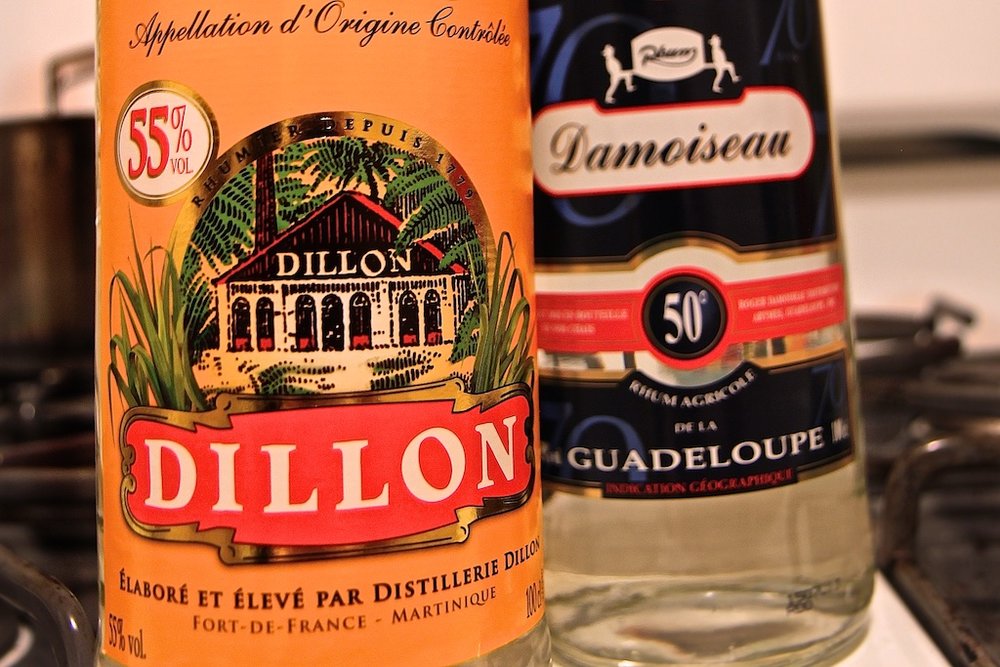Le Rhum

Whenever I come back from France people inevitably ask me if brought any interesting Cognac, Armagnac, or wine back with me. I almost always fill my suitcase with booze whenever I make a trip anywhere, but seeing how much great Cognac, Armagnac, and wine we already import to K&L I don't really have a need for more beyond that. What I do have a need for are things that I like to drink, but are of a nature that I would never be able to purchase large quantities for the store. Things like Agricole Rhum, the French West Indies version of what we call call "rum" (that's supposed to be funny). All kidding aside, not everyone understands what makes Agricole Rhum different from standard molasses-based rums, and I know this because I still get people coming back into the store thinking their bottle of Neisson has "gone bad". They wanted to buy a high-end bottle of rum to make Mojitos, they saw the beautiful French label, the $40 price point, and—much like me when I look at these bottles—they were captivated by the romanticism.
But—alas—they opened the bottle and were blasted in the face by a grassy, funky, herbaceous, 55% force of pure nature. Or agriculture, you could say. What makes Agricole Rhum so different? It's distilled from pure sugar cane juice, rather than fermented molasses, and all that inherent sugar cane flavor comes through in the spirit. Why do they make it that way? It's a long story (and an interesting one), but the abbreviated version has to do with the collapse of the French West Indies sugar industry around 1870 after the discovery of beet sugar. If you don't have active sugar refineries, you don't have molasses, which means no more molasses-distilled rum. But don't think that the residents of Martinique and Guadaloupe were going to stop distilling alcohol just because they didn't have molasses. Sugar cane has sugar in it, right? Where there's sugar, there's potential alcohol. Voila! Nous avons de rhum! If you find this story interesting you should investigate beyond my brief synopsis because it's really fascinating.
I had never tasted rhums from Dillon (from Martinique) or Damosieau (from Guadaloupe) before, so I grabbed a few liters from CdG duty free and brought them on the plane. When I got back home I had to stop by my neighbor's house to get my mail, and I asked him if he wanted to have a Daiquiri seeing that I had all this new stuff try out. He's from Puerto Rico and he loves rum, so I was expecting an affirmative answer. When I handed him his cocktail I carefully watched his face to gauge his reaction: "This is rum?" he asked confused. It took him a few sips to come around, but eventually I told him the story and he was instantly compelled. He took the caps off and smelled the bottles: "This reminds me of being a kid," he told me. "We would walk by sugar cane fields, break of a piece, and suck out all of the juice. This smells exactly like that." Even my Caribbean-born, rum-loving neighbor had no idea there was a different style of rum out there.
"It's kind of like blue cheese," I said. "You don't necessarily love blue cheese as a kid, but over time you grow to enjoy the pungent flavor. Agricole rhum is definitely an acquired taste." How do you drink it? Daiquiris are good. Ti Punch is the classic drink, of course, but there's an entirely unique cocktail culture out there based around these potent flavors. I wish we could carry an entire section of just Agricole Rhum at K&L, but unfortunately we're not there yet. We need a bit more time to get our customers acquired to these funky flavors before we start making larger strides. In the meantime, I'll keep loading my suitcase with French rhum each time I head to Paris.
-David Driscoll
